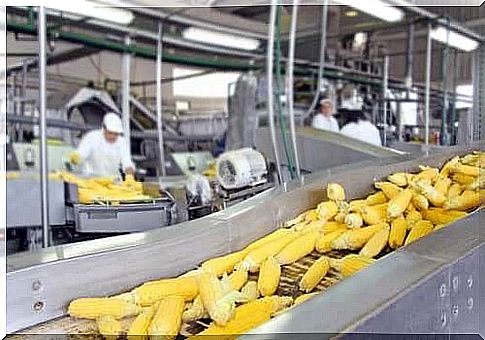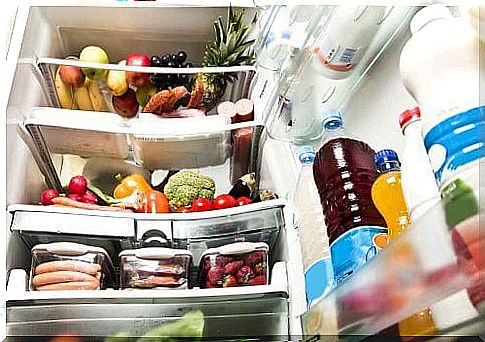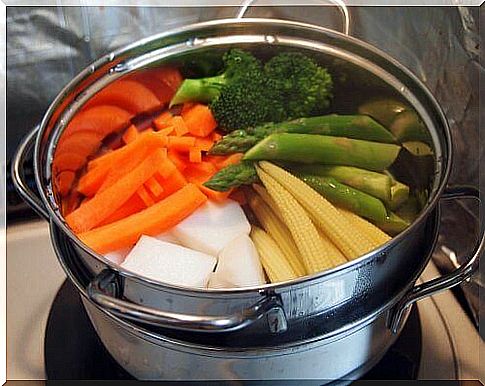The Impact Of Industrial Processes On The Nutritional Value Of Foods

Foods require treatments that prevent their spoilage, as over time the biochemical structure of foods and beverages changes and they are therefore no longer suitable for human consumption. In this process, the nutritional value of the food also changes. This is why we want to tell you more in this article about the impact of industrial processes on the nutritional value of food.
Impact of industrial processes on the nutritional value of foods
Some foods, such as milk, meat, fish, vegetables, and fruits, spoil faster than other foods. This is because these foods contain more water than, for example, nuts, which in turn can be stored for much longer periods of time.
The food industry applies industrial processes to the food and drink we eat for four fundamental reasons:
- Eliminates the risk of the spread of diseases associated with the presence of micro-organisms in raw products.
- Gives food a pleasant taste and facilitates their consumption and digestibility.
- Eliminates factors present in certain raw materials that act as so-called anti-nutrients. Antidoteins are both naturally occurring and synthetic compounds that interfere with the normal absorption of nutrients into the body.
- They prevent food spoilage, allowing them to last longer and we can enjoy them for longer than normal.
What kind of industrial processes can be applied to food?
There are several industrial processes that reduce or completely eliminate the potential growth of microorganisms lurking in food. In addition, these processes seek to avoid chemical and biochemical reactions that cause deterioration or spoilage of food.
The following is an explanation of the most common industrial processes used by the food industry, which are certainly already familiar to many of us, as we also use them in our own kitchens on a daily basis:
Refrigeration and freezing of food

Refrigeration and freezing are the main methods for maintaining the nutritional value of food because they inhibit the enzymatic effects of food and the growth of bacteria. In both methods, the loss of nutritional value of the food is very small or even non-existent, as these products are produced exclusively by packaging, freezing or defrosting if the cold chain of the food is broken for one reason or another.
Therefore, when we defrost frozen food, we have to defrost it in the refrigerator because in foods thawed at room temperature, microorganisms grow faster.
Food drying
In this method, water is removed from the food either completely or partially. The effects on its nutritional value are as follows:
- Vitamins in some foods are lost due to high temperatures.
- Proteins denature, i.e., lose their natural structure.
- The organoleptic properties of a food (such as appearance, taste, smell or composition) change.
Pasteurization of food
Pasteurization is applied in most cases to either dairy products or vegetables. Although some important vitamins are lost in the process, it is important to try to avoid so-called “raw” or non-pasteurized dairy products, as they may contain pathogenic or disease-causing microbes and other organisms.
Food sterilization
It is a very efficient method performed with the help of heat, as it eliminates disease-causing microbes, other plant organisms and spores. Because of its effectiveness, it negatively affects many nutrients in food, and in particular vitamins that are lost through heat, as well as the biological value of proteins due to the so-called Maillard reaction.
Heating food
All vegetables, except onions, must be heated with water or steam before freezing. This process helps to reduce the microbial load and inactivate enzymes that can cause the formation of strange tastes in food during storage.
The heating of the foodstuffs is carried out either in water, the temperature of which must be between 90 and 100 degrees, or by heating in steam, the temperature of which must be between 120 and 130 degrees. The food is heated for about 2-10 minutes, depending on the composition. While this process is effective, it usually results in a partial loss of both vitamins and minerals. This is why frozen vegetables and fruits have fewer vitamins and minerals than fresh vegetables and fruits.
Cooking food
Cooking food is one of the most common industrial processes in which food is cooked at a temperature of about 100 degrees. In this process, a significant part of the vitamins and minerals is transferred to the cooking water and therefore it is recommended to use this cooking water in other cooking as well, if possible.
Cooking benefits the nutritional value of a food, including:
- In the case of certain foods, such as legumes, potatoes, and eggs, cooking increases the bioavailability of some nutrients, i.e., the efficiency of their absorption in the digestive tract.
- Cooking improves the bioavailability of proteins and complex carbohydrates.
- Cooking enhances the organoleptic properties of food, such as color and taste.

Frying food in fat
It is an industrial process in which food is cooked in fat at a high temperature for a short time. The effects of frying food on nutritional value are as follows:
- Frying food results in a loss of nutritional value of the proteins.
- In frying, oxidizing fats lead to the appearance of toxic compounds.
- Frying destroys the vitamins in the food.
- Frying increases the energy value of food.
Microwave heating of food
Microwaves emit low-energy electromagnetic radiation that cannot be ionized. Therefore, they are unlikely to generate free radicals, so that microwave heating does not result in compounds that would alter the organoleptic properties of the food or could be considered toxic.
Heating food in the oven
Heating the food in the oven exposes the food to a uniform and constant heat, allowing the food to cook and change or improve its structure. Baking in the oven affects the nutritional value as follows:
- Heating in the oven results in the loss of proteins through the Maillard reaction and the loss of vitamins through heat.
- It increases the digestibility of proteins.
- It results in the loss of anti-nutrients.
- Heating in an oven increases the bioavailability of B vitamins.
Roasting food
This is a process similar to oven baking, but this method specifically seeks a crunchy texture in the food. Roasting food leads to nutritional losses of proteins and vitamins, especially thiamine.
As we can see, thanks to the processes mentioned above, we make foods last longer while avoiding microbes and bacteria that can potentially carry diseases and illnesses that are harmful to our bodies.
At the same time, however, it is good to understand how significant the impact of some industrial processes on the nutritional value of foods actually is, and what manufacturing methods we can get the most out of their vitamins and minerals. However, if you follow a healthy and varied diet, luckily you won’t have to worry about the effects of these methods, which they can alter in your original nutrients.









